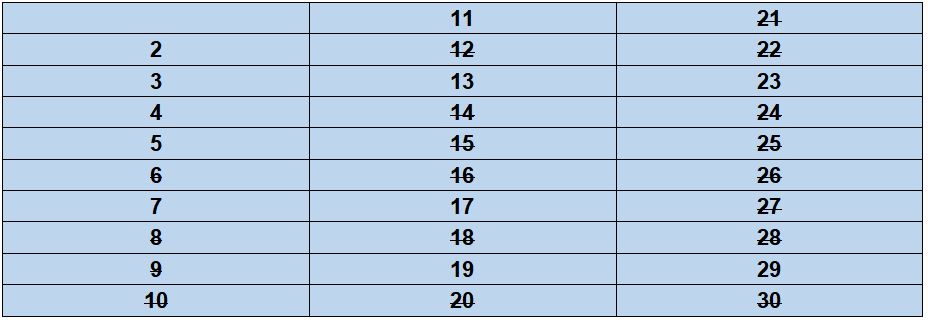Prime Numbers: Go through this article to study Prime Numbers, including their definition, examples, properties, steps to find prime numbers, their applications and so on. Delve into these meticulously crafted notes to gain a thorough understanding of prime numbers and their significance in various mathematical contexts.
Definition of Prime Numbers
A prime number is a natural number greater than 1 that has no positive divisors other than 1 and itself. In other words, a prime number is a number that cannot be formed by multiplying two smaller natural numbers.
Properties of Prime Numbers
- A prime number p has exactly two distinct positive divisors, 1 and p itself.
- If p is a prime number and divides a product ab, then p must divide at least one of a or b.
- Every even number greater than 2 can be expressed as the sum of two prime numbers.
- There is only one even prime number which is 2.
- Any two prime numbers are always co-prime to each other.
- Every integer greater than 1 can be represented uniquely as a product of prime numbers.
Examples of Prime Numbers
Here are some examples of prime numbers:
- 2 (the only even prime number)
- 3
- 5
- 7
- 11
- 13
- 17
- 19
- 23
- 29and more
Identifying Prime Numbers
To determine if a number is prime, you can use the following steps:
(i) Check if the number is greater than 1. Prime numbers must be greater than 1.
(ii) Check divisibility: Divide the number by all integers greater than 1 and less than the square root of the number. If the number is not divisible by any of these integers, it is prime.
Example: Is 29 a prime number?
Solution: 29 is greater than 1.
- Check divisibility by all integers up to √29 ≈ 5 (approx.)
- 29 is not divisible by 2, 3, 4 or 5.
- Therefore, 29 is a prime number.
Prime Numbers 1 to 100
| Prime Numbers from 1 to 10 | 2, 3, 5, 7 |
| Prime Numbers from 11 to 20 | 11, 13, 17, 19 |
| Prime Numbers from 21 to 30 | 23, 29 |
| Prime Numbers from 31 to 40 | 31, 37 |
| Prime Numbers from 41 to 50 | 41, 43, 47 |
| Prime Numbers from 51 to 100 | 53, 59, 61, 67, 71, 73, 79, 83, 89, 97 |
Prime Factorization
Every natural number greater than 1 can be expressed uniquely as a product of prime numbers. This is known as prime factorization.
Example: Prime factorization of 60
Step 1: Start with the smallest prime number, 2: 60 ÷ 2 = 30
Step 2: Continue dividing by 2: 30 ÷ 2 = 15
Step 3: 15 is not divisible by 2, so move to the next prime number, 3: 15 ÷ 3 = 5
Step 4: 5 is a prime number.
Step 5: Therefore, the prime factorization of 60 is 2x2×3×5.
The Sieve of Eratosthenes
The Sieve of Eratosthenes is an ancient algorithm used to find all prime numbers up to a given limit. It works by iteratively marking the multiples of each prime number starting from 2.
Steps:
- List all numbers from 2 up to the desired limit.
- Start with the first number in the list (2). Mark all multiples of 2.
- Move to the next number in the list that is not marked (this will be 3). Mark all multiples of 3.
- Repeat the process for the next unmarked number.
- The remaining unmarked numbers are primes.
Example: Find primes up to 30.
Step 1: Starting with 2, mark all multiples of 2, i.e., 4, 6, 8, 10, ..., 30.
Step 2: Next unmarked number is 3, mark all multiples of 3, i.e., 6, 9, 12, ..., 30.
Step 1: Continue with 5, then 7, and so on.
So, the prime numbers are the unmarked ones: 2, 3, 5, 7, 11, 13, 17, 19, 23, 29,
Applications of Prime Numbers
- Cryptography: Prime numbers are fundamental in cryptographic algorithms, such as RSA encryption, which is widely used for secure data transmission.
- Number Theory: Prime numbers are a central topic in number theory, with many open questions and unsolved problems related to them.
- Computer Science: Prime numbers are used in hashing algorithms, random number generation, and error detection.
Interesting Facts about Prime Numbers
- Twin Primes: A twin prime is a pair of prime numbers that differ by 2. For Example, 11 and 13.
- Twin Prime Conjecture: The twin prime conjecture posits that there are an infinite number of twin primes, or equivalently that there is no largest twin prime pair.
- Largest Known Prime: As of now, the largest known prime number is 282,589,933 − 1, a number which has 24,862,048 digits when written in base 10.
Prime numbers are a fundamental and captivating area of mathematics. They are essential for understanding the structure and properties of numbers, and their study continues to reveal new insights and applications in various fields.
You might be interested to Know:
Dividing Fractions: Concepts, Definition, Formula and Types
Pythagoras Theorem: Definition, Formula, Proof, Examples and Applications



Comments
All Comments (0)
Join the conversation